Muck Diving - The Deadly Flower Urchin
I learnt about Muck Diving when I was in Lembeh, a term created for dives done in muddy or mucky sea environment.
Most of the time you find only sand, or mud, along with dead corals and more sand when you go for a muck diving.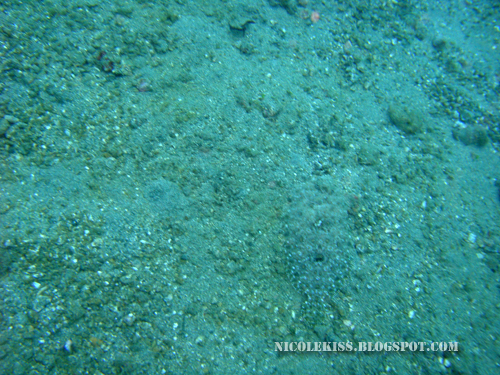
Technically speaking, muck diving is a rather boring dive, especially for amateur divers. And can be the worst form of dive to take your first ever dive experience (discovery scuba - for people who have yet to get your first diving license)
Before you think it's complete lunacy for me to fly cross the sea just to land myself in some secluded god forsaken place to see sand underwater, keep in mind that muck diving does has its own attractiveness.
Basically, the common motto of muck dive: Not all is what it seems.
Do you see anything? Almost making it out the shadow outlining the sandy bottom?
What thing is that weirdly shaped camouflaged thing?
Look closer.
Muck diving is like going on a treasure hunt with a tank and mask, except you don't know what you're looking for.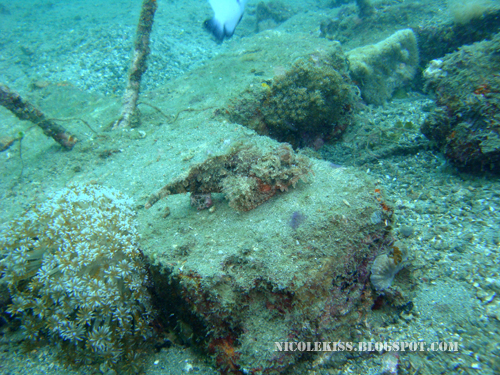
There are abundance of juvenile creatures and exotic organisms living among the hiddens. It's almost a thrill when you're able to spot one.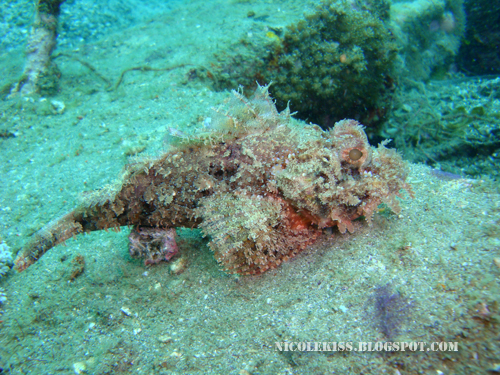
Most muck diving are done in South East Asia because of the rich marine lives on offer, so if you're an avid diver and you live here, it's insane not to do at least a muck dive trip in your life.
Some of the common living things are colorful nudibranch (a.k.a. sea slugs) or sometimes, colorless shrimps.
Which are quite easy to spot when you scout around the singled-out coral on the sea bed.
Well, almost quite easy.
A coral such as this is like a oasis in a dessert - they're not very common but when there's one, it's a sanctuary for all. So usually there are more than one living things hiding amongst it.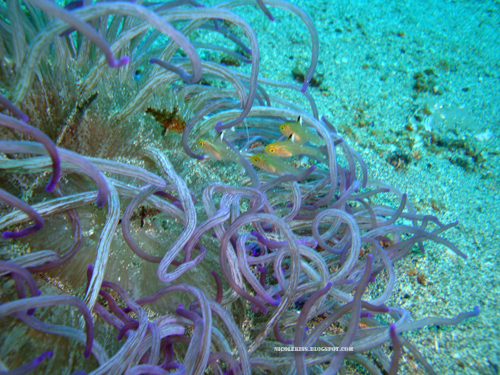
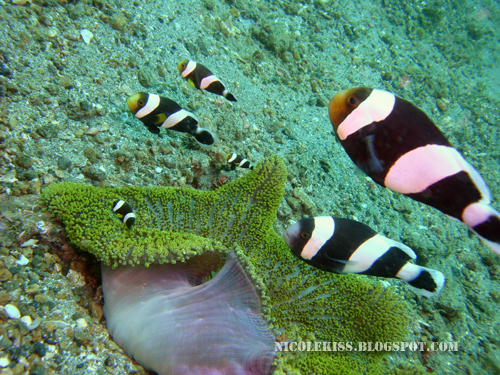
clown fish family
The other reason why muck diving can appear very dull is because the marine lives in the muck are able to disguise themselves very well.
Almost too well for some.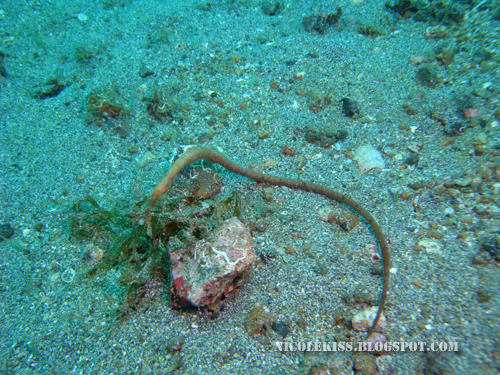
From far you might just think that this is a rope, stranded sea grass or worm at most.
But if you know your fish well, you know it's actually a bloody worm-like fish!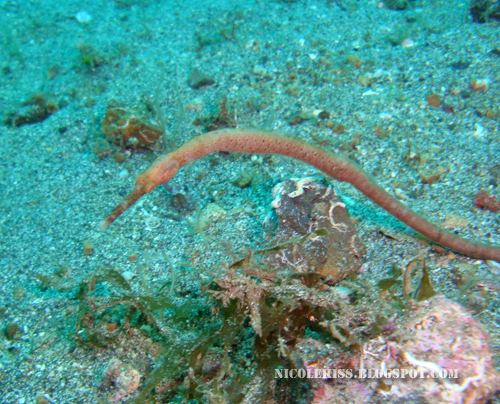
It looks like a rope, acts like a rope, but it's not a rope.
In this case, assuming we're all newbies, following a local guide is the best way to spot unusual underwater creatures.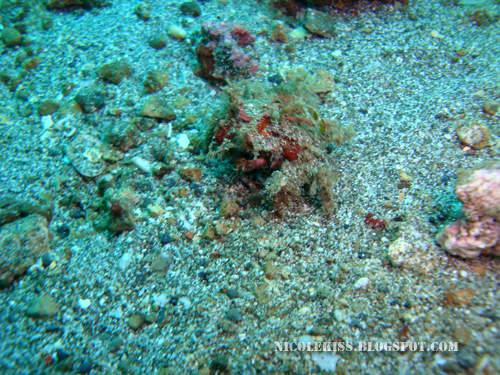
Looks like a common coral or a rock?
NO!
Meet... the decorator crab.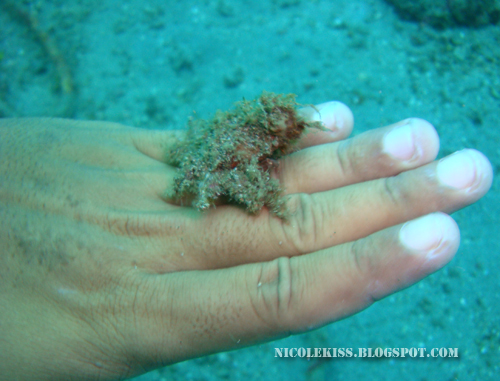
Here's a video of how camouflaged a fish can be at the sandy bottom of the sea.
Click on the video and look closely in the beginning 2 seconds if you can spot anything at all.
Poor bugger was being chased by me all the way.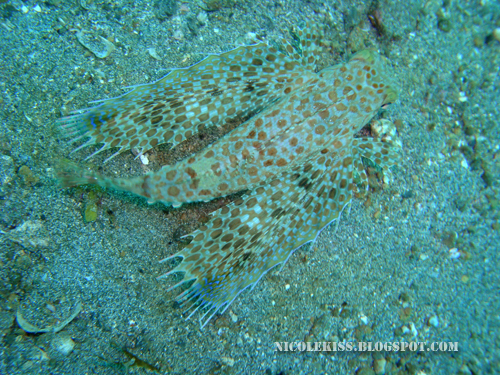
Until it lifted its spike in the end feeling threatened before I left it alone.
Scary!
Among other fish, I also stumbled upon a few more odd ones.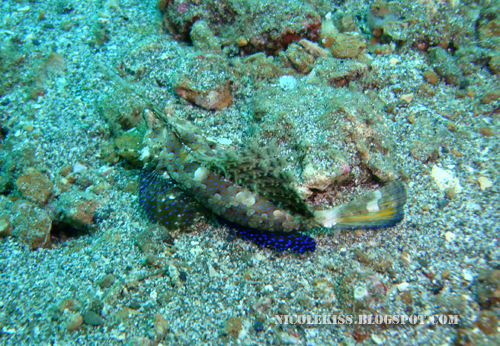
Colorful with a really long spike on its head. Reason why this is the closest photo I have of it.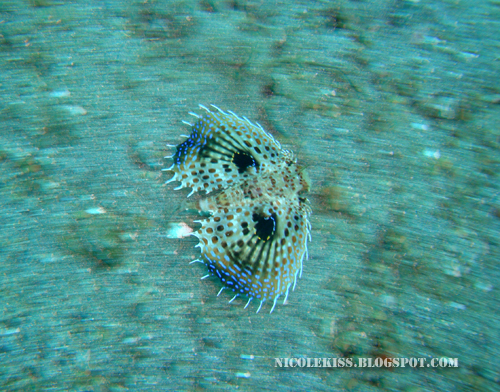
some moth looking fish.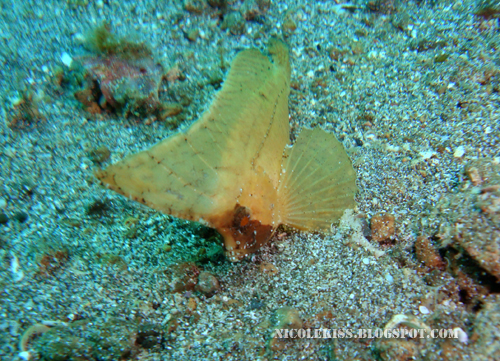
a common fish to spot during muck dives - waspfish!
Personally I like this fish a lot. Reminds me of leaffish. (click here for leaffish photo)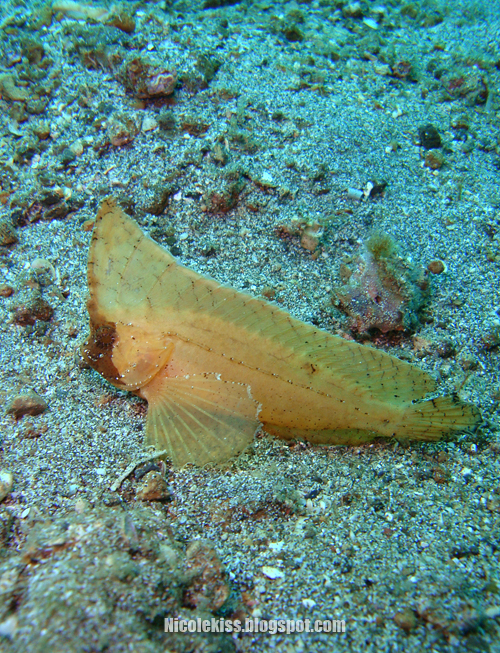
Not all unusual and exotic are marine lives though. Corals can be pretty quirky here too.
Looks like a bunch of condom balloons.
I always had a penchant of touching things around me (bad habit of mine last time, note: past tense :p). But for some reasons I wasn't too keen in touching that one.
Oh, about that. Here's a little tale of mine that almost took my life during this dive. *drama*
You know corals are fun to touch as long as you know you don't do harm to it (for critics: corals don't die after you touch them, they only die when you pick them up from the ocean and they harden and die, or when you pluck them from their habitat, they might die; but the common corals WON'T die if you just gently brush your finger along it just to feel its texture).
Though common knowledge is, don't touch what you're not familiar with!
So I was smart when I come across a coral-like urchin on the sea bed.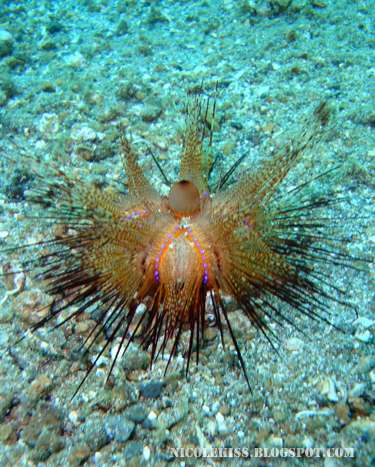
The warning statement "DO NOT TOUCH IT" flashed across my mind like a neon banner on a Casino in Las Vegas.
Like duh! Who would touch such a dangerous looking thing?! That.. that THING looks like it has a thousand needles protruding out in all possible direction, ready to penetrate and injure anyone that comes pass it.
I thought I was smart to just leave it alone and not get too close to it.
But what would you think when you come across something like this?
I was feeling all proud of myself being cautious and all when I came upon this... this.. pretty "pot of flowers"-looking coral? Which I later found out was a Flower Urchin.
Sweet name, yes?
NO!!
So basically what happened was, I felt attracted to the pretty little thing that I swam up to it and was observing it up close, tempting my finger to touch its pretty little "petal"... closing in... closing in...
When my dive master appeared out of no where. Snap my hand so hard I was thrown back in water and looked dead to me in the eye...
and did one signal no diver would ever want to see.
'He swept his hand horizontally across his neck.' - indicating.... DEATH.
(or out of breath if you're talking about oxygen left in your tank)
When I returned to the lodge after the dive. I immediately sat down and looked up flower urchin in the dive books most dive lodge have.
This was what I found - the Flower Urchin is "extremely dangerous", it can be very deadly despite it attractive outlook.
Multiple times MORE DANGEROUS than the long-spined urchin I saw and avoided earlier.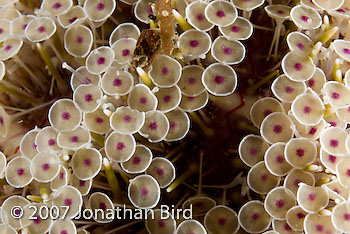
The pretty petals on the flower urchin are actually venomous pincers able to cause paralysis or even death!
According to this page about Flower Urchin, if you don't die from the sting, "The sting results in intense radiating pain, prickling or numbness, abnormally low blood pressure, respiratory distress, and muscular paralysis all of which lasting anything up to 6 hours."
So that means you would also drown from the sting, which could also result in death.
*Gulp*
Right. From this day on, I will never ever ever ever... touch a coral ever again!
*touch no evil*
Well, maybe just the corals Nemo swims in. :p
(nah just kidding hehe)


7 kissed Nicole
u aren't supposed to touch ANYTHING underwater
ReplyDeletela la la
ReplyDelete(note: past tense)
Lucky you, pheww ....
ReplyDeleteThe world is beautiful, isn't it! Full of mystery and surprise. Who would have think that such a beautiful thing is so deadly!
ReplyDeleteWow, so pretty and deadly!
ReplyDeleteThese are lovely specimens...I'm glad I get to see them on your blog, 'cos I'd never go diving to see them!
its so beautiful!
ReplyDeletesuper beautiful. love it
ReplyDelete